

The area sometimes referred to as the "fertile crescent", which includes much of the modern countries of Iraq, Syria, Jordan, Iran and Turkey, was where domestication is currently dated as earliest in the world. In general, the "crescent" is the upland area in a crescent-shape around the Tigris and Euphrates Rivers, the two large rivers that drain into the Persian Gulf. (See Map Below, and text p. 212)
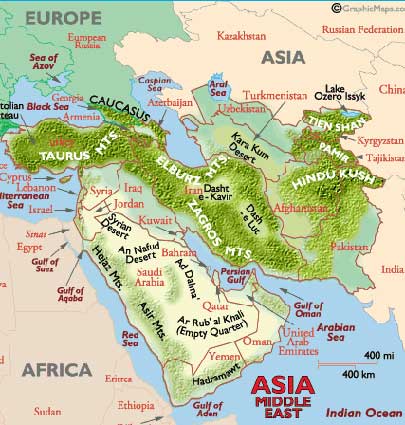
At the end of the Pleistocene, large fauna became more scarce, while wild cereals became more common due to the change in climate. People developed new tools to harvest the wild grasses, including sickles of flint blades inserted into wooden or bone handles, baskets to carry the seeds, grinding slabs process the seeds, and underground storage pits, some waterproofed by plastering. The text discusses one such site, 'Ain Mallaha in modern Israel. [see text p. 209-210] (See below for some examples of these artifacts, which preadapted the people to horticulture.) As population rose, those who moved into domestication could produce more calories per unit area of land than those who remained foragers. More calories, even if of lesser quality, enabled more population growth, which necessitated a rapid and complete move to horticulture.
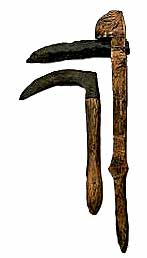
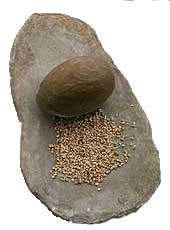
Sickles with flint blades (l) and Grinding stone or mortar, with pestle (r)

Hafted Ground Stone Ax Head
The text in general does an excellent discussion of places and dates for early horticulture in southwest Asia (the Middle East). Most of these sites referred to are in a stage archaeologists call Pre-pottery Neolithic A, B and C, because pottery is absent or minimal at such sites. Sites like Abu Hureyra in Syria [see text pp. 214-217, and also below], the Palestinian site of Jericho [see text pp. 221-223], Jarmo in Iraq, and Ali Kosh in Iran and 'Ain Ghazal in Jordan are examples of some of the earliest sites of food production. All are villages of various sizes, some at least partially walled. In these areas the earliest domesticated wheat, rye, barley, lentils, goats, sheep, and cattle are found during the time period of 10,000 to 6,000 BC. (You are not required to read the above links on these sites, though they are recommended [note the study guide for sites you are supposed to know a bit about]; however see below for the required link in this lesson.)
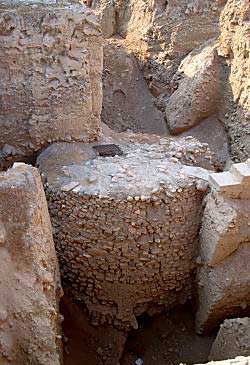

Tower at Jericho, in the Remains of the Walls (l) and Plastered Skull from the same site
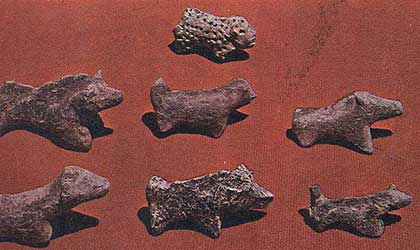
Unbaked Clay figurines from Jarmo: Toys or Offerings?
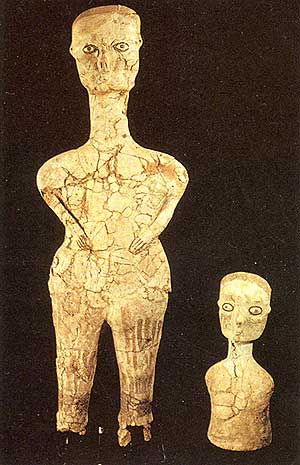
Plaster statue and Bust from 'Ain Ghazal, Jordan (Click on link for more on these statues.)
Abu Hureyra
Located on the Eurprates River in northern Syria, Abu Hureyra is a site that spans the transition from Mesolithic foragers using a broad spectrum of wild plants (particularly grasses) and wild animals, to a full Neolithic dependence on plant and animal domestication. At its height the site covered some 30 ares, and was occupied from 10,500 BC to 6,000 BC. The tell or mound left behind was as much as 25 feet high.
Abu Hureyra is one of the sites that are part of lab 3, so be sure to read about it in more detail in Chapter 6. The site contains evidence of perhaps the earliest domesticated grain, rye, dating at 10,000 BC. In addition, remains of 162 people were discovered, and an analysis of their bones reveals considerable information about what life was like in Neolithic Abu Hureyra. This is discussed below, but also see the required link on the site.
Physical anthropologists who study human bones from archeological sites can often provide insight as to how people spent their working lives. Repetitive or habitual labor, such as squatting or carrying heavy loads on the head, will signs of these activities on peoples' bones. Analysis of the Abu Hureyra remains found squatting facets on the front side of the ankles, found on the bones of both men and women, as well as children. In some adults, the upper neck vertebrae were enlarged, indicating that heavy loads were carried on the head. In addition, many older adults, particularly women, showed severely arthritic big toes, and many (even younger individuals) had a degernative condition where the big toe is bent upwards. This condition is a result of constant kneeling with the toes tucked under the foot, a condition that in Abu Hureyra is probably the result of long periods spent grinding grain.
Among the artifacts found at Abu Hureyra are stone querns or grinding stones. Constant use of these querns creates a shallow depression in middle, which is why they are often identified as saddle querns. Women probably ground grain on these querns daily, using the weight of their bodies to grind the grain, and the "bent-back" big toes as a base to apply force to the grinding. (See below.)

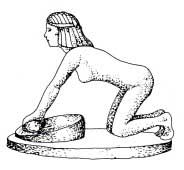
Saddle Quern from Abu Hureyra, and a sketch of the typical grinding posture, with bent toes
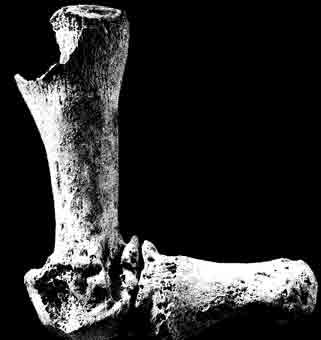
Deformed Toe Bones of a woman of Abu Hureyra
Both male and females bones showed well-marked areas of muscle attachment, particularily of the deltoid muschles of the upper arms. Many also had heavily abraded teeth, a result of eating coarse grain. While the site does not have any pottery until near the end of its occupation, it is possible that Abu Hureyra people made fiber baskets. Constantly chewing basket fiber to soften it leaves typical grooving on the teeth, which is found on the teeth of Abu Hureyra women.